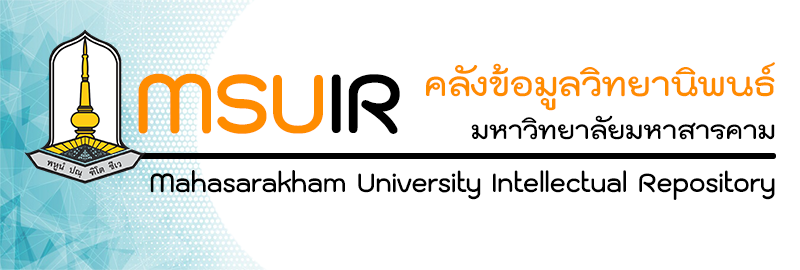Please use this identifier to cite or link to this item:
http://202.28.34.124/dspace/handle123456789/2852| Title: | DEVELOPING OF SYSTEMS THINKING FOR MATTHAYOMSUKSA 5 STUDENTS IN ELECTROSTATIC THROUGH MODEL-BASED LEARNING WITH CONCEPT MAPPING การพัฒนาการคิดเชิงระบบสำหรับนักเรียนชั้นมัธยมศึกษาปีที่ 5 เรื่องไฟฟ้าสถิต โดยใช้การจัดการเรียนรู้เเบบจำลองเป็นฐานร่วมกับเเผนผังมโนทัศน์ |
| Authors: | Tanakon Kongped ธนกร กงเพชร Kanyarat Cojorn กัญญารัตน์ โคจร Mahasarakham University Kanyarat Cojorn กัญญารัตน์ โคจร kanyarat.c@msu.ac.th kanyarat.c@msu.ac.th |
| Keywords: | แบบจำลองเป็นฐาน แผนผังมโนทัศน์ การคิดเชิงระบบ Model – Based Learning Concept Mapping System Thinking |
| Issue Date: | 14 |
| Publisher: | Mahasarakham University |
| Abstract: | The purpose of this research was to develop system thinking by using model-based learning with concept mapping in Electrostatic topics that achieved at least 70% of total scores. The study was conducted to investigate 32 Matthayomsuksa 5 students at Sarakhampittayakhom School, MahaSarakham, in the second semester of the academic year 2023. The target group was selected through a purposive sampling method. This study used action research, which consisted of 3 cycles. The research tools included 1) plans of model-based learning with concept mapping in Electrostatic topics total 9 plans with 14 hours, 2) 3 sets of system thinking assessments which were situational subjective tests, consisting of 2 situations each, and 3) the observations. The statistics used were percentage, mean values, and standard deviation (S.D.).
The results for the first cycle showed that there were 10 students gaining 70 percent of the full score, and was counted as 31.25 percent of all students. It was found in the second cycle that the number of students who passed the test increased to 17 which was 53.13 percent of the whole number of students. Lastly, in the third cycle, the results revealed that there were 26 students passing the test and the percentage was up to 81.25. It can be concluded that the number of students participating in the model-based learning with concept mapping and gaining passing scores was higher. Therefore, it could be concluded that the model-based learning with concept mapping could develop the students’ systems thinking. การวิจัยครั้งนี้มีวัตถุประสงค์เพื่อพัฒนาการคิดเชิงระบบของนักเรียนชั้นมัธยมศึกษาปีที่ 5 เรื่อง ไฟฟ้าสถิต โดยใช้กิจกรรมการเรียนรู้แบบจําลองเป็นฐานร่วมกับแผนผังมโนทัศน์ให้ผ่านเกณฑ์อย่างน้อยร้อยละ 70 โดยนักเรียนกลุ่มเป้าหมายเป็นนักเรียน 32 คน โรงเรียนสารคามพิทยาคม อำเภอเมืองมหาสารคาม จังหวัดมหาสารคาม ภาคเรียนที่ 2 ปีการศึกษา 2566 โดยได้มาจากการเลือกแบบเจาะจง วิจัยครั้งนี้ใช้รูปแบบของการวิจัยเชิงปฏิบัติการ ซึ่งมีวงรอบปฏิบัติการ 3 วงรอบ เครื่องมือที่ใช้ในการวิจัย ได้แก่ 1) แผนการจัดการเรียนรู้โดยใช้แบบจำลองเป็นฐานร่วมกับแผนผังมโนทัศน์ ชั้นมัธยมศึกษาปีที่ 5 จำนวน 9 แผน เรื่อง ไฟฟ้าสถิต รวม 14 ชั่วโมง 2) แบบวัดการคิดเชิงระบบ ซึ่งเป็นข้อสอบอัตนัย จำนวน 3 ชุด มีลักษณะเป็นข้อสอบอัตนัยเชิงสถานการณ์จำนวน 2 สถานการณ์ต่อชุด โดยแต่ละสถานการณ์มี 3 ข้อย่อย 3) แบบสังเกตพฤติกรรมของนักเรียน สถิติที่ใช้ในการวิเคราะห์ข้อมูล ได้แก่ ค่าเฉลี่ย ร้อยละ และ ส่วนเบี่ยงเบนมาตรฐาน ผลการวิจัยพบว่าจากนักเรียนทั้งหมด 32 คน นักเรียนที่มีคะแนนผ่านเกณฑ์ร้อยละ 70 มีจำนวนเพิ่มขึ้นดังนี้ ในวงรอบปฏิบัติการที่ 1 พบว่ามีนักเรียนที่มีคะแนนผ่านเกณฑ์ร้อยละ 70 ของคะแนนเต็ม จำนวน 10 คน คิดเป็นร้อยละ 31.25 ของนักเรียนทั้งหมด วงรอบปฏิบัติการที่ 2 พบว่านักเรียนที่ผ่านเกณฑ์มีจำนวนเพิ่มขึ้นเป็น 17 คน คิดเป็นร้อยละ 53.13 ของนักเรียนทั้งหมด และในวงรอบปฏิบัติการที่ 3 พบว่านักเรียนที่ผ่านเกณฑ์มีจำนวน เพิ่มขึ้นเป็น 26 คน คิดเป็นร้อยละ 81.25 ของนักเรียนกลุ่มเป้าหมายทั้งหมด สรุปได้ว่านักเรียนที่ได้รับการจัดกิจกรรมการเรียนรู้มีการพัฒนาการคิดเชิงระบบผ่านเกณฑ์อย่างน้อยร้อยละ 70 ดังนั้นการจัดกิจกรรมการเรียนรู้โดยใช้แบบจำลองเป็นฐานร่วมกับแผนผังมโนทัศน์ สามารถพัฒนาการคิดเชิงระบบของนักเรียนกลุ่มเป้าหมายได้ |
| URI: | http://202.28.34.124/dspace/handle123456789/2852 |
| Appears in Collections: | The Faculty of Education |
Files in This Item:
| File | Description | Size | Format | |
|---|---|---|---|---|
| 65010554024.pdf | 9.2 MB | Adobe PDF | View/Open |
Items in DSpace are protected by copyright, with all rights reserved, unless otherwise indicated.

